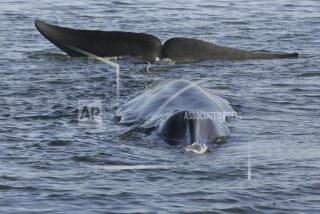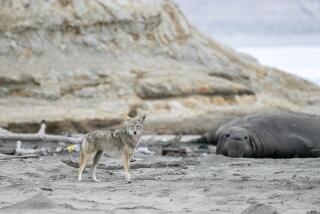Plans for Seal Safaris Put Norway in a Dilemma
HVALER ISLANDS, Norway — The frostbitten fishermen along this coast of broken clouds know that killing seals requires deft public relations.
“The animal rights activists are giving the wrong image of what’s happening,” said Kurt Alan Hansen, a fish wholesaler in a blustery cove that opens to the North Sea. “People see this stuff of a man punching a seal and blood all over and they think Norwegians are crazy.”
Things may get crazier -- and outrage more intense -- when gunshots start crackling through the fjords in January. New Norwegian wildlife regulations will for the first time permit tourists to hunt seals in an effort to cull a population that devours tons of valuable seafood and is prone to a disease known in these parts as the plague.
At least two adventure travel outfits are offering holiday packages to experienced and “rookie” hunters to shoot the much-loved pinniped amid these tiny islands speckling the cold sea. One company expects to make six figures from the seal safaris by catering to U.S. and European clients.
Environmental groups have protested on the Internet, and a prompt letter of rebuke was sent by Brigitte Bardot, the French actress and animal rights activist whom fishermen regard as more irritating than a boatload of tangled nets. “Do not accept hordes of bloodthirsty tourists visiting your country for the sole purpose of reaping the skin of these poor innocent and peaceful animals,” she wrote to the Norwegian people.
Whaling and seal hunting have been common endeavors in this seafaring nation for generations. In recent years, however, fewer hunters have ventured along the coast and seal colonies are expected to multiply. Under lobbying by fishermen, the Norwegian Fisheries Ministry recently doubled the seal kill quota to 2,000 and persuaded parliament to invite “foreign hunters” in to pursue their prey with licensed guides.
Fisheries Minister Svein Ludvigsen first raised the idea of tourists shooting seals several years ago.
“I know that people in the travel industry are good at seeing possible ways of making money. This is one such possibility,” he told a Norwegian trade publication. “Seal hunting in wild Norwegian coastal nature could be sold as an exclusive product to tourists.... This could be a hit.”
The 2,000-seal quota is higher than recommended by Norwegian scientists. Cull numbers in recent years have been about half that figure. The environmental group Greenpeace has urged that the government, instead of targeting more seals, rely on what the organization claims are more ecological options to protect fishing stocks, including expanding marine reserves and reducing the fleet.
“They blame the seal for everything that’s wrong in the ocean,” said Truls Gulowsen, a Greenpeace activist. “This hunting is being looked upon as barbaric. It will absolutely hurt the image of Norway as a tourist destination. Shooting seals for fun does not fit in with the unspoiled scenic nature of this country.”
The fishermen on this smattering of islands near the Swedish border -- where shrimp trawling began on sailboats more than 200 years ago -- pay little attention to such condemnation. Their days are spent outsmarting tides, snow squalls, broken engines and lost anchors. Seals to them are slippery competitors, navigating ice floes and whitecaps while robbing trawler nets of flickering whorls of cod and shrimp.
Shooting seals does not alarm most Norwegians either. They are raised to accept the fishermen’s point of view, and they understand that changing seasons bring new hunting cycles. But some are baffled that their government would allow even a hint of tourism to be associated with the culling of a watery-eyed creature that evokes passion around the world.
“It’s not about tourists coming to Norway with their guns and out of control,” said Sigbjorn Larsen, an exasperated spokesman for the Fisheries Ministry who has the delicate task of explaining the policy to the public. “This is for hunters. They must have licenses, and they’re not allowed to kill baby seals. Brigitte Bardot is running amok.”
When harbor and gray seal populations are not reduced, the government insists, the animals often become infected with ailments, including a fatal respiratory epidemic known as phocine distemper virus. The Fisheries Ministry stated that “large numbers” of seals died in 2002 of disease. The appetites of growing seal colonies also mean that fishermen -- easily affected by environmental and economic shifts -- catch less cod, shrimp, lobster and other delicacies.
Even a year after it was thinned by illness in 2002, the large seal population around the Hvaler islands resulted in fewer shrimp caught by the 50 boats that supply Hansen’s FjordFish wholesalers. In the first 39 weeks of 2003, Hansen said, fishermen delivered 640 tons of shrimp. In that same time span this year, with fewer seals along the coast, shrimp stocks began to replenish and the catch rose to 825 tons. The cod statistics were similar -- 39 tons in 2003 and 69 tons this year.
“You have to have the right seal numbers,” Hansen said. “Otherwise, the seals live in pain and die of disease and the fishing catch goes down. The government should have gone out and explained this better.”
The adventure outfit NorSafari is offering four-day seal hunting trips in January for $1,300, including a $320 refund if hunters aren’t brought within shooting range. Kjell Arne Hovland, a NorSafari executive, told the Norwegian media that seal hunting next year was expected to bring his company about $160,000.
“It hasn’t hurt their business,” Larsen, the ministry spokesman, said of NorSafari and other like groups. “The opposite has happened. People are coming. Americans. Germans. Dutch. And TV stations are coming to follow the story.”
Hunters might want to target seal for meat, fur or just sport.
Ivar Martinsen, a shrimp fisherman with squiggles of gray in his red beard, agreed that seals are kind of cute. He knows they elicit more sympathy than, say, moose, which are also hunted in Norway.
But sometimes, the fisherman said while docking his boat, seals have to be shot to protect the balance between man and nature and commerce.
“We don’t want the seals to go extinct,” said Martinsen, as strong winds riffled the island cove and rattled fishing shacks. “But if you don’t keep their numbers down, they die of the plague. In 2002, the plague killed thousands of seals. They were floating dead across the water.”
He hosed off his shrimp and added, “A seal eats 5% of his weight in fish every day. Last week, I tried to chase a seal cub away but he just lay there on his back, eating a fish and ignoring me.
“I think a lot of people look upon the seal as a kind of human being. They pop up out of the water with these big eyes and they have this sort of humanity about them.”
Few would accuse Martinsen of being a seal-hugger, but other fishermen were less philosophical. “Shoot ‘em,” said one when he overheard a discussion about seals. Another boat owner, Vidar Barm, said the plague was a painful disease, adding, “It’s better for the seal to get a bullet in the head than to swim around sick and half dying.”
By midafternoon, more boats were churning through rough water toward the cove. Vats steamed, shrimp were cooked and ice was piled high when a 50-foot trawler docked after five days at sea. Crew member Lars Olsen scampered over the deck and climbed the stairs to the cabin. Looking out the window toward the jetty and the gray sky, he said a bunch of seals were sitting on the rocks around the lighthouse. It was a vision that seldom thrills him.
“There’s a lot more out there than people are saying,” he said.
More to Read
Sign up for Essential California
The most important California stories and recommendations in your inbox every morning.
You may occasionally receive promotional content from the Los Angeles Times.











